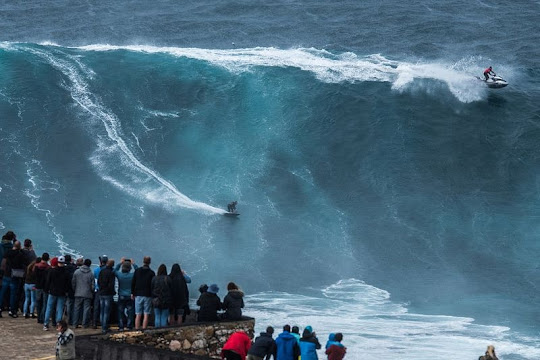The pretty seaside town and resort of Nazaré on the west coast of Portugal remains crowded throughout the summer with tourists who flock to its long sandy beaches to relax, swim and surf. But when winter arrives, only the most serious thrill seekers stay. At this time, the beaches are dangerous. Massive waves up to 100 feet high regularly break along the rocky coastline.
Nazare’s monster waves attract big wave surfers from all around, but until very recently, the town and its surfing potential was relatively unknown outside Europe. Nazare hit headlines only in November 2011 when Hawaiian surfer Garrett McNamara surfed a record breaking giant wave measuring 78 feet from trough to crest. In January 2013, McNamara returned to Nazare and broke his own record by successfully riding a wave that was estimated to be 100 feet tall. Later in October the same year, Brazilian big-wave hero Carlos Burle rode a wave that appeared to be even bigger. Nazaré on the Atlantic coast has now become a legendary spot in the world of big wave surfing.

A massive wave breaks at Nazaré in Portugal.
How does Nazaré manage to generate waves of colossal size with such regularity? The answer lies in Nazare's rare undersea geography. Just off the coast of Nazare is the biggest underwater ravine in Europe called Nazaré Canyon. This huge canyon runs 125 miles from the abyssal plain of the Atlantic Ocean to less than half a mile from the coastline, pointing towards the town like an arrow. At its deepest point, the canyon floor is more than 3 miles beneath the surface and it rises rapidly to a canyon “headwall” that rises to between 100 and 150 feet just off the coast of Praia do Norte beach, which is where some of the biggest waves has been known to occur.
The swells originate in the North Atlantic from giant storms in wintertime, and as they arrive near Nazare their energy gets focused and amplified by the narrow canyon just like a magnifying glass focuses the suns energy into a small region. From the headwall to the coastline, the seabed rises abruptly that enables the waves to climb really big all of a sudden. Just before it reaches the coastline, the sea becomes shallow enough for the now amplified swells to break in gigantic waves.
All other big wave spots around the globe — Teahupoo in Tahiti, the Banzai Pipeline in Hawaii, and Mavericks off northern California — have similar undersea geography.


Surfer Sebastian Steudtner from Germany rides a big wave, while above a crowd watches from the cliffs at Praia do Norte in Nazaré.



A surfer drops in on a large wave at Praia do Norte, in Nazare December 11, 2014. Praia do Norte beach has gained popularity with big wave surfers since Hawaiian surfer Garrett McNamara broke a world record for the largest wave surfed here in 2011.

Crowds seen watching on the cliffs at Praia do Norte.

Waves reaching the lighthouse in Nazaré as the first big swell of the year arrives.

Crowds seen watching surfers from the cliff at Praia do Norte.
Source
READ MORE»
Nazare’s monster waves attract big wave surfers from all around, but until very recently, the town and its surfing potential was relatively unknown outside Europe. Nazare hit headlines only in November 2011 when Hawaiian surfer Garrett McNamara surfed a record breaking giant wave measuring 78 feet from trough to crest. In January 2013, McNamara returned to Nazare and broke his own record by successfully riding a wave that was estimated to be 100 feet tall. Later in October the same year, Brazilian big-wave hero Carlos Burle rode a wave that appeared to be even bigger. Nazaré on the Atlantic coast has now become a legendary spot in the world of big wave surfing.

A massive wave breaks at Nazaré in Portugal.
How does Nazaré manage to generate waves of colossal size with such regularity? The answer lies in Nazare's rare undersea geography. Just off the coast of Nazare is the biggest underwater ravine in Europe called Nazaré Canyon. This huge canyon runs 125 miles from the abyssal plain of the Atlantic Ocean to less than half a mile from the coastline, pointing towards the town like an arrow. At its deepest point, the canyon floor is more than 3 miles beneath the surface and it rises rapidly to a canyon “headwall” that rises to between 100 and 150 feet just off the coast of Praia do Norte beach, which is where some of the biggest waves has been known to occur.
The swells originate in the North Atlantic from giant storms in wintertime, and as they arrive near Nazare their energy gets focused and amplified by the narrow canyon just like a magnifying glass focuses the suns energy into a small region. From the headwall to the coastline, the seabed rises abruptly that enables the waves to climb really big all of a sudden. Just before it reaches the coastline, the sea becomes shallow enough for the now amplified swells to break in gigantic waves.
All other big wave spots around the globe — Teahupoo in Tahiti, the Banzai Pipeline in Hawaii, and Mavericks off northern California — have similar undersea geography.


Surfer Sebastian Steudtner from Germany rides a big wave, while above a crowd watches from the cliffs at Praia do Norte in Nazaré.



A surfer drops in on a large wave at Praia do Norte, in Nazare December 11, 2014. Praia do Norte beach has gained popularity with big wave surfers since Hawaiian surfer Garrett McNamara broke a world record for the largest wave surfed here in 2011.

Crowds seen watching on the cliffs at Praia do Norte.

Waves reaching the lighthouse in Nazaré as the first big swell of the year arrives.

Crowds seen watching surfers from the cliff at Praia do Norte.
Source







 Malaspina Glacier.
Malaspina Glacier.






















